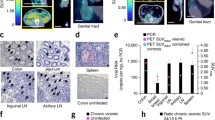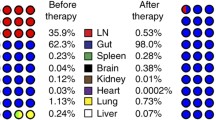Abstract
Purpose
To characterise tissue sites of immune activation and HIV replication we performed FDG-PET in ART-treated and ART-naive HIV-infected individuals. Specific aims were to establish whether HIV-infected patients can be differentiated on the basis of the detection of specific locations of viral replication, even in the presence of an apparently optimal immunovirological response to ART, and whether these FDG-PET findings can be related to immunovirological variables and AIDS history status.
Patients and methods
Patients were divided into five groups as follows: subgroup A1 (full responders, n = 8): current ART treatment, CD4+ T lymphocytes >500/mL, viral load <50 copies/mL; subgroup A2 (full responders, n = 5): same criteria as A-1, but with a previous history of AIDS; subgroup A3 (immunological non responders, n = 5): current ART treatment, viral load <50 copies/mL, low CD4+ T lymphocytes (<200/mL); group B (virological non responders, n = 2): current ART treatment, CD4+ T lymphocytes around 500/mL, viral load >50,000 copies/mL; group C (ART-naïve, n = 5): no current or previous ART treatment, increased viral load.
Results
PET images revealed different patterns of FDG uptake. All ART-treated patients with either suppressed (<50 copies/mL; Group A) or high viremia (group B) showed a normal pattern of FDG uptake. On the contrary, the ART-naïve subjects with high viraemia (group C) displayed multiple foci of increased glucose metabolism in the lymph nodes. In the ART-naïve subjects, FDG uptake, apparently related to viraemia level, was observed in the upper torso mainly in the axillary nodes bilaterally in patients with viraemia below 100,000 copies/mL; in those with viraemia higher than 100,000 copies/mL, FDG uptake was also observed in the inguinal lymph nodes.
Conclusions
The emergence, in our study, of a correlation between the percentage of CD8+/CD38+/RO+ T cells (well established markers of progression to AIDS independently of CD4+ T lymphocytes) and positive FDG-PET in ART-naive patients is a novel finding that seems to confer prognostic value on FDG uptake. FDG uptake is strongly associated with response to ART independently of a previous AIDS diagnosis. Notably, no differences were observed between ART-treated subjects classed as immunological responders and those classed as non responders. Data herewith indicate that FDG uptake and immunological variables are unrelated when ART is being administered. This is evidence of the complementarity of immunological and FDG measures. FDG uptake is a sensitive marker of disease state and its relation with CD8+/CD38+/CD45RO+ T cells indicates that it can be considered a marker of disease status. The lack of a correlation between FDG uptake and immunological variables in patients under ART warrants further investigation.

Similar content being viewed by others
References
Bental M, Deutsch C. Metabolic changes in activated T-cells—an NMR study of human peripheral-blood lymphocytes. Magn Reson Med 1993;29:317–26.
Brand KA, Hermfisse U. Aerobic glycolysis by proliferating cells: a protective strategy against reactive oxygen species. FASEB J 1997;11:388–95.
Ishimori T, Saga T, Mamede M, Kobayashi H, Higashi T, Nakamoto Y, et al. Increased (18)F-FDG uptake in a model of inflammation: concanavalin A-mediated lymphocyte activation. J Nucl Med 2002;43(5):658–63. May.
Scharko AM, Perlman SB, Hinds PW 2nd, Hanson JM, Uno H, Pauza CD. Whole body positron emission tomography imaging of simian immunodeficiency virus-infected rhesus macaques. Proc Natl Acad Sci U S A 1996;93(13):6425–30. Jun 25.
Wallace M, Pyzalski R, Horejsh D, Brown C, Djavani M, Lu Y, et al. Whole body positron emission tomography imaging of activated lymphoid tissues during acute simian–human immunodeficiency virus 89.6PD infection in rhesus macaques. Virology 2000;274(2):255–61. Sep 1.
Iyengar S, Chin B, Margolick JB, Sabundayo BP, Schwartz DH. Anatomical loci of HIV-associated immune activation and association with viraemia. Lancet 2003;362:945–50.
Scharko AM, Perlman SB, Pyzalski RW, Graziano FM, Sosman J, Pauza CD. Whole-body positron emission tomography in patients with HIV-1 infection. Lancet 2003;362:959–61.
Brust D, Polis M, Davey R, Hahn B, Bacharach S, Whatley M, et al. Fluorodeoxyglucose imaging in healthy subjects with HIV infection: impact of disease stage and therapy on pattern of nodal activation. AIDS 2006;20(7):985–93. Apr 24.
Giorgi JV, Liu Z, Hultin LE, Cumberland WG, Hennessey K, Detels R. Elevated levels of CD8+ CD38+ T cells in HIV infection add to the prognostic value of low CD4+T cell levels: results of 6 years follow-up. J Acquir Immune Defic Syndr 1993;6:904–12.
Bofill M, Mocroft A, Lipman M, Medina E, Borthwick NJ, Sabin CA, et al. Increased numbers of primed activated CD8+ CD38+ CD45RO+ T cells predict the decline of CD4+T cells in HIV-1-infected patients. AIDS 1996;10:827–34.
Vigano A, Saresella M, Rusconi S, Ferrante P, Clerici M. Expression of CD38 on CD8 T cells predicts maintenance of high viraemia in HAART-treated HIV-1-infected children. Lancet 1998;352:1905–7.
Giorgi JV, Hultin LE, McKeating JA, Johnson TD, Owens B, Jacobson LP, et al. Shorter survival in advanced human immunodeficiency virus type 1 infection is more closely associated with T lymphocyte activation than with plasma virus burden or virus chemokine coreceptor usage. J Infect Dis 1999;179:859–70.
Koning FA, Otto SA, Hazenberg MD, Dekker L, Prins M, Miedema F, et al. Low-level CD4(+) T cell activation is associated with low susceptibility to HIV-1 infection. J Immunol 2005;175:6117–22.
Acknowledgements
We would like to express our sincere thanks to Dr. Cathrine Wrenn for her excellent revision of the text, language and copy editing. This study was supported in part by grants from the Istituto Superiore di Sanita’ “Programma Nazionale di Ricerca sull’AIDS”; the EMPRO and AVIP EC WP6 projects; the GISHEAL and nGIN EC WP7 projects; the Japan Health Science Foundation; 2007 Ricerca Finalizzata [Italian Ministry of Health]; 2007 Ricerca Corrente [Italian Ministry of Health] and progetto FIRB RETI, Rete Italiana Chimica Farmaceutica CHEM-PROFARMA-NET [RBPR05NWWC], and a grant from the Istituto Clinico Humanitas.
Author information
Authors and Affiliations
Corresponding author
Additional information
The authors declare no conflicts of interest.
Rights and permissions
About this article
Cite this article
Lucignani, G., Orunesu, E., Cesari, M. et al. FDG-PET imaging in HIV-infected subjects: relation with therapy and immunovirological variables. Eur J Nucl Med Mol Imaging 36, 640–647 (2009). https://doi.org/10.1007/s00259-008-1023-7
Received:
Accepted:
Published:
Issue Date:
DOI: https://doi.org/10.1007/s00259-008-1023-7




